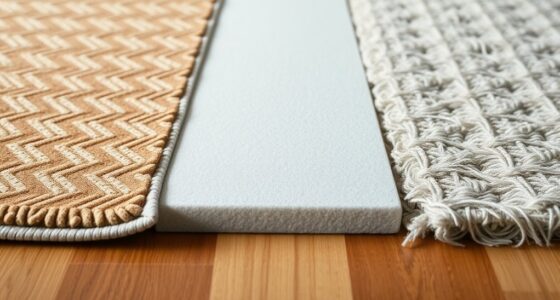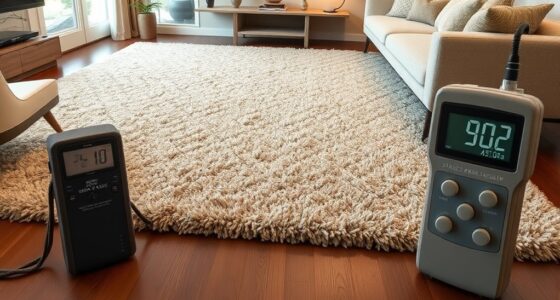Formaldehyde is a common indoor pollutant that can off-gas from rugs made with synthetic fibers, adhesives, and dyes, affecting your indoor air quality and health. Natural fiber rugs like wool and cotton usually emit fewer chemicals. To reduce exposure, select low-emission rugs, guarantee proper ventilation, and regularly clean your carpets. If you want to learn more about how to keep your indoor air safe and healthy, keep exploring these important facts.
Key Takeaways
- Formaldehyde emissions from synthetic rugs and treated fibers can degrade indoor air quality and cause health issues.
- Natural fiber rugs like wool and cotton typically emit lower levels of formaldehyde and other VOCs.
- Proper ventilation, regular cleaning, and choosing low-emission, certified rugs reduce indoor formaldehyde levels.
- New rugs, especially synthetic ones, may off-gas formaldehyde for months, requiring careful selection and maintenance.
- Using air purifiers with HEPA filters and maintaining HVAC systems helps remove formaldehyde and improve indoor air quality.
Understanding Formaldehyde: What It Is and Why It Matters
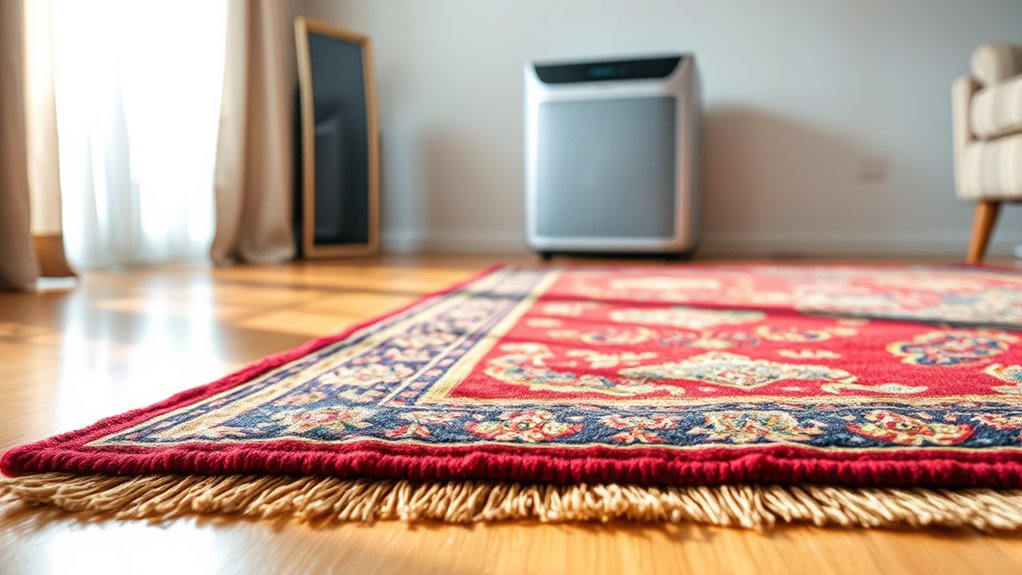
Formaldehyde is a colorless, strong-smelling gas commonly found in many household products, including certain rugs and furniture. It’s often released from the manufacturing of synthetic fibers used in rugs, which can emit this chemical over time. Many rugs made with synthetic fibers are treated with chemical preservatives or adhesives that contain formaldehyde, contributing to indoor air pollution. Additionally, synthetic dyes used in some rugs may also contain formaldehyde-based chemicals, further increasing chemical emissions indoors. Understanding this chemical’s presence helps you recognize the potential risks in your home. Formaldehyde can cause health issues like respiratory irritation and allergies, making it essential to be aware of its sources and how it can linger in indoor environments, especially within rugs. Indoor air quality can be significantly affected by these chemical emissions, emphasizing the importance of proper ventilation and air purification. Awareness of formaldehyde emissions is crucial for maintaining a healthier indoor environment. Recognizing chemical off-gassing during and after installation can help minimize exposure and improve overall air safety.
Common Indoor Sources of Formaldehyde
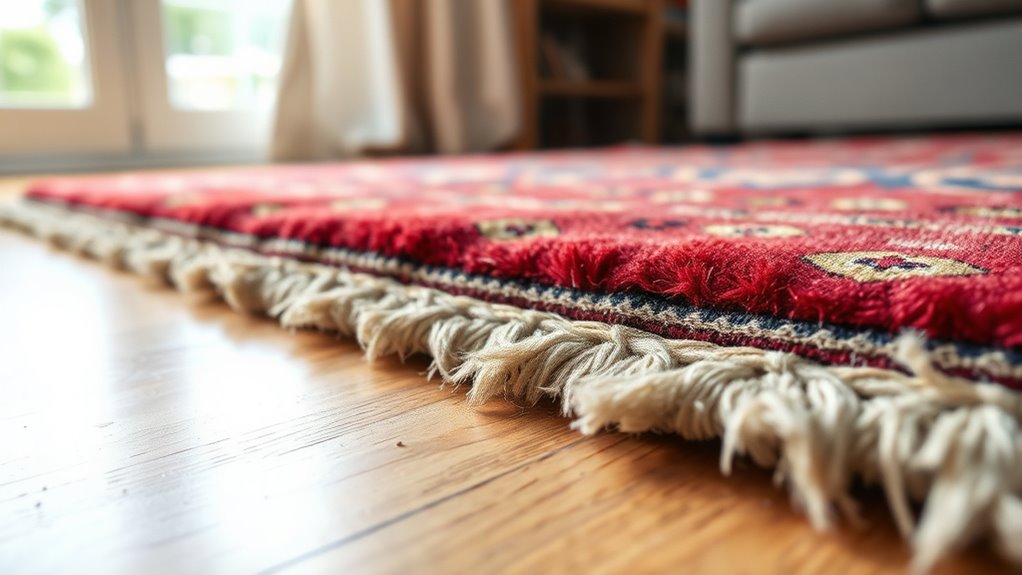
Many household items and building materials release formaldehyde into indoor air, often without you realizing it. Common sources include furniture made with pressed wood, particleboard, and plywood, which often contain formaldehyde-based adhesives. Additionally, synthetic fibers used in carpets, curtains, and upholstery can emit formaldehyde over time. Dye chemicals applied to fabrics and textiles may also release formaldehyde as a preservative or finishing agent. Heating or humidity increases the release rate, making indoor environments more susceptible to elevated formaldehyde levels. Being aware of these sources helps you reduce exposure. Vetted – Grobal World Proper ventilation, choosing low-emission products, and using air purifiers can help minimize formaldehyde buildup from these indoor sources. Recognizing the safety standards and certifications that brands adhere to can also ensure you select products with minimal formaldehyde emissions. Additionally, understanding the emission rates of various materials can aid in making safer choices for your indoor environment. Employing air quality monitoring devices can provide real-time insights into formaldehyde levels and help you take timely action.
The Role of Rugs in Indoor Air Quality
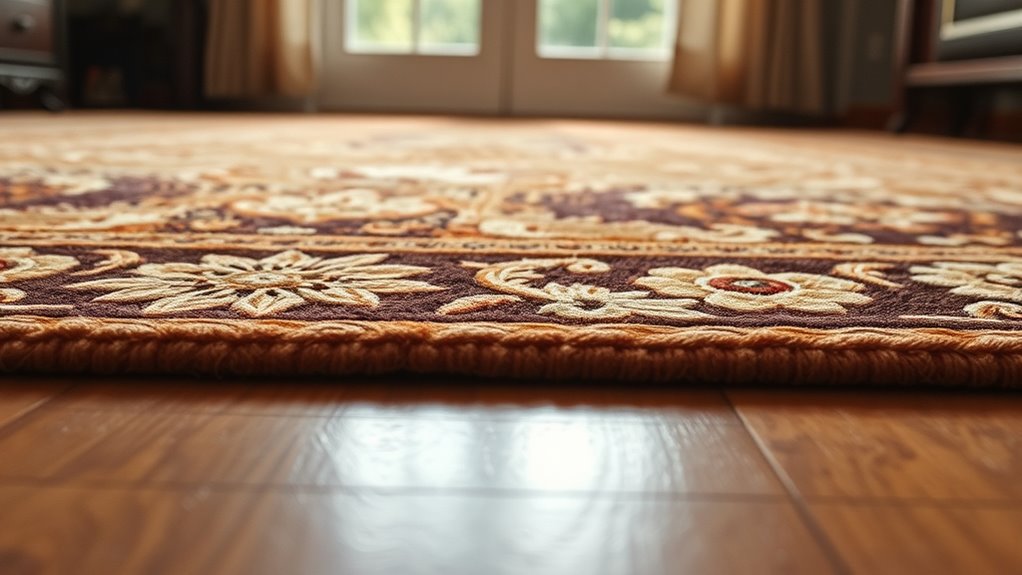
Rugs can trap pollutants like dust and allergens, turning into hidden reservoirs that affect indoor air quality. The materials used in your rugs influence how much they emit and retain contaminants. Regular cleaning can considerably reduce these pollutants, helping to improve the air you breathe indoors. Additionally, choosing rugs made from low-emission materials can further minimize indoor air pollution. Using rugs made from self-watering plant pots or similar eco-friendly materials can also support healthier indoor environments by reducing chemical emissions. Incorporating security measures such as surveillance cameras or alarm systems can enhance safety and prevent break-ins that might threaten indoor air quality through associated disturbances or damages. Promoting awareness of indoor air pollutants can encourage better choices in home environment management.
Rugs as Pollutant Reservoirs
While rugs can add warmth and style to your indoor space, they also serve as hidden reservoirs for pollutants. Over time, dust, allergens, and volatile compounds settle into the fibers, making cleaning more difficult. The fiber durability influences how well pollutants are trapped and released, while dye stability affects chemical retention, especially if treatments or dyes emit fumes. To minimize risks, consider:
- Regular vacuuming to remove surface particles
- Choosing rugs with high fiber durability
- Selecting dyes with proven stability
- Using air purifiers to reduce airborne pollutants
Understanding how your rug’s fiber strength and dye stability impact pollutant retention helps you create a healthier environment. Proper maintenance prevents pollutants from lingering and being re-released into your indoor air, safeguarding your health. Additionally, decluttering your space can reduce hidden dust and allergens that accumulate in cluttered areas, further improving indoor air quality. Being aware of the pollutant reservoirs in your home can help you take targeted actions to enhance air quality and reduce health risks. Regular cleaning techniques can also influence the chemical emission levels from dyes and treatments, making careful selection essential. Maintaining a regular cleaning schedule can also prevent the buildup of indoor pollutants and improve overall air quality.
Material Impact on Emissions
The materials used in rug construction markedly influence the types and amounts of emissions released into your indoor environment. Synthetic fibers, such as nylon or polyester, often emit volatile organic compounds (VOCs), including formaldehyde, especially when new. These fibers can off-gas for months, impacting indoor air quality. Conversely, natural fibers like wool or cotton tend to emit fewer chemicals, making them a healthier choice. Additionally, the dyes used in rugs matter; natural dyes typically release fewer emissions compared to synthetic dyes, which may contain chemicals that contribute to indoor pollution. Choosing rugs made from natural fibers and dyes can substantially reduce your exposure to harmful emissions, creating a safer, healthier indoor space. Always check product labels and opt for eco-friendly options when possible. Automation in business is also influencing how manufacturing processes are optimized to reduce emissions and improve sustainability. Incorporating proper ventilation during and after rug installation can further mitigate indoor air pollution by dispersing any residual emissions more effectively. Moreover, selecting rugs with low-VOC certifications can help ensure minimal chemical off-gassing in your home environment. Furthermore, ongoing research into emission reduction technologies continues to offer promising solutions for healthier indoor air quality.
Cleaning Reduces Contaminants
Regular cleaning plays a crucial role in reducing airborne contaminants that can settle into your rugs and impact indoor air quality. Effective cleaning techniques help remove rugs and allergens that accumulate over time, minimizing health risks. By regularly vacuuming and deep cleaning your rugs, you prevent the buildup of dust, pet dander, and other irritants. Incorporating anti-aging effects from treatments like eye patches demonstrates how targeted skincare can also improve appearance and well-being. Proper maintenance also includes asset division strategies to ensure your belongings are properly managed during cleaning routines, especially when considering shared or rented spaces. Additionally, choosing the right vacuum cleaner with appropriate filtration systems, such as HEPA filters, enhances the removal of fine particles from your environment. Key ways to improve indoor air quality include: – Using HEPA filters during vacuuming – Steam cleaning to eliminate deep-seated allergens – Regularly shaking out or airing rugs outdoors – Applying eco-friendly cleaning solutions Implementing these techniques ensures your rugs stay cleaner and healthier, reducing airborne contaminants and improving overall indoor air quality. Consistent maintenance is essential for creating a safer, more comfortable living environment.
Types of Rugs That Are More Likely to Emit Formaldehyde

Synthetic rugs made from nylon, polyester, or other petrochemical fibers are more likely to emit formaldehyde. These synthetic fibers often contain resins and dyes that release formaldehyde over time. In contrast, rugs made from natural fibers like wool, cotton, or jute generally emit less formaldehyde. The table below highlights key differences:
| Material Type | Formaldehyde Emissions | Durability | Environmental Impact |
|---|---|---|---|
| Synthetic fibers | Higher | Very durable | Less eco-friendly |
| Natural fibers | Lower | Less durable | More eco-friendly |
| Wool | Low to moderate | Durable | Biodegradable |
| Cotton | Low | Moderate | Biodegradable |
| Jute | Very low | Less durable | Biodegradable |
Choosing rugs with natural fibers can help reduce formaldehyde exposure indoors.
Recognizing Signs of Formaldehyde Exposure
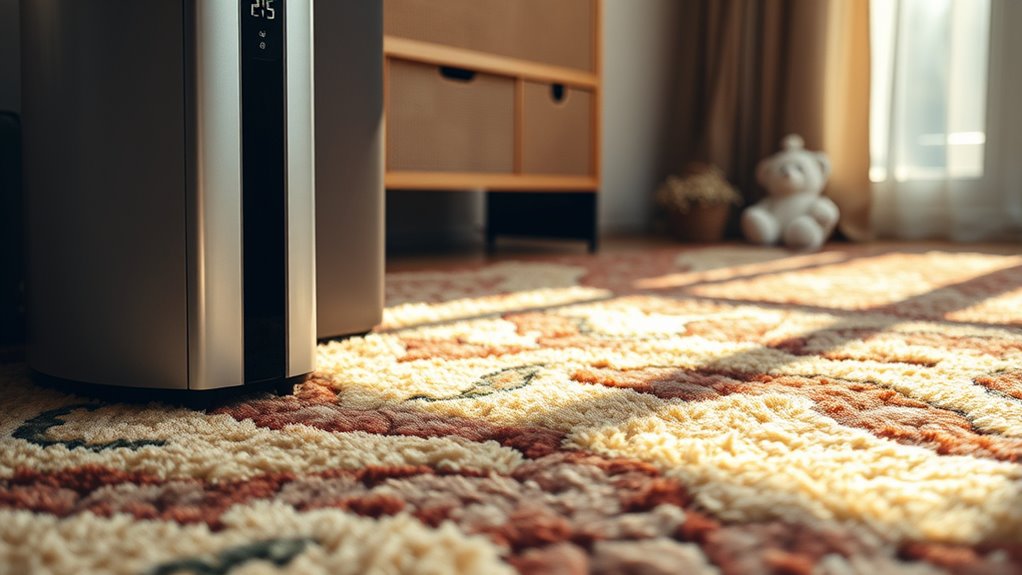
If you notice your eyes feeling itchy or burning without an obvious cause, it could be a sign of formaldehyde exposure. Persistent coughs, sore throats, or breathing difficulties might also indicate indoor air issues. Additionally, a strong chemical smell lingering in your home is often a warning sign to investigate further.
Unusual Eye Irritation
Unusual eye irritation can be an early warning sign of formaldehyde exposure from rugs and indoor air pollutants. You might notice persistent eye discomfort or vision irritation that doesn’t improve. This reaction occurs because formaldehyde vapors can irritate the sensitive tissues in your eyes. Recognizing these signs early helps prevent further health issues. Be alert to these symptoms:
- Redness and watering
- Burning sensation
- Sensitivity to light
- Blurred vision
If you experience these symptoms after bringing new rugs into your home, formaldehyde exposure could be the cause. Addressing the source quickly can help reduce eye discomfort and protect your overall health. Always consider improving ventilation or removing potential formaldehyde sources when symptoms appear.
Persistent Respiratory Issues
Persistent respiratory issues can develop as a response to ongoing formaldehyde exposure from rugs and indoor air pollutants. You might notice coughing, wheezing, or shortness of breath that doesn’t improve over time. These symptoms often signal your lungs are reacting to irritants in the air, especially if you’ve recently brought new rugs into your home. To counteract this, consider using air purification systems designed to filter out formaldehyde and other toxins. Proper air purification can reduce your exposure, easing your breathing and preventing further irritation. Additionally, taking steps for allergy prevention, like increasing ventilation and removing sources of formaldehyde, can help minimize symptoms. Recognizing these signs early is vital for protecting your respiratory health and maintaining indoor air quality.
Unpleasant Chemical Odor
A strong, chemical-like odor in your home can be a key sign of formaldehyde exposure from rugs and other indoor sources. You might notice a sharp, persistent smell that lingers long after unpacking or installing new rugs. This unpleasant chemical odor often resembles the scent of rug fragrances but is more intense and irritating. If you detect this smell, it could indicate elevated formaldehyde levels in your indoor air. Be alert to these signs:
- Lingering chemical odors after cleaning or airing out
- Unusual smells that don’t match rug fragrances
- Smells that worsen with temperature increases
- Persistent odors despite ventilation efforts
Recognizing these signs helps you identify potential formaldehyde sources and take action to improve your indoor air quality and health.
How Formaldehyde Off-Gasses From Rugs
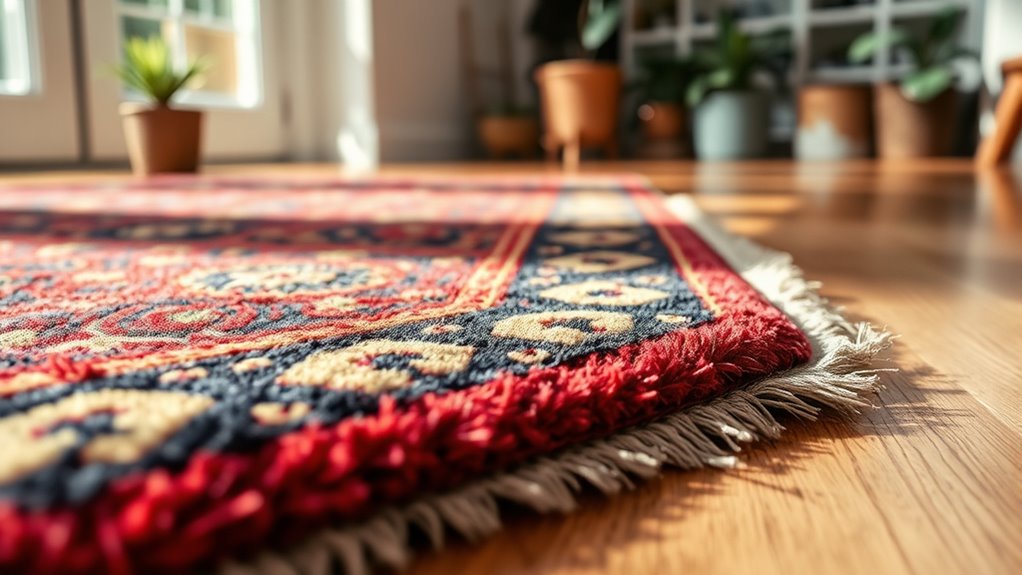
Formaldehyde can off-gas from rugs as they release volatile organic compounds (VOCs) into your indoor air. Rugs made from synthetic fibers are particularly prone to this, as these materials often involve chemical treatments during manufacturing. These treatments can include adhesives, dyes, and flame retardants, all of which may contain formaldehyde or cause it to off-gas over time. When you walk across the rug or vacuum it, these VOCs are released into the air you breathe. Off-gassing can continue for months or even years, especially in poorly ventilated spaces. To reduce exposure, consider choosing rugs made from natural fibers or those labeled as low-emission. Proper ventilation and air purification can also help minimize formaldehyde levels in your home.
Tips for Choosing Low-Emission Rugs
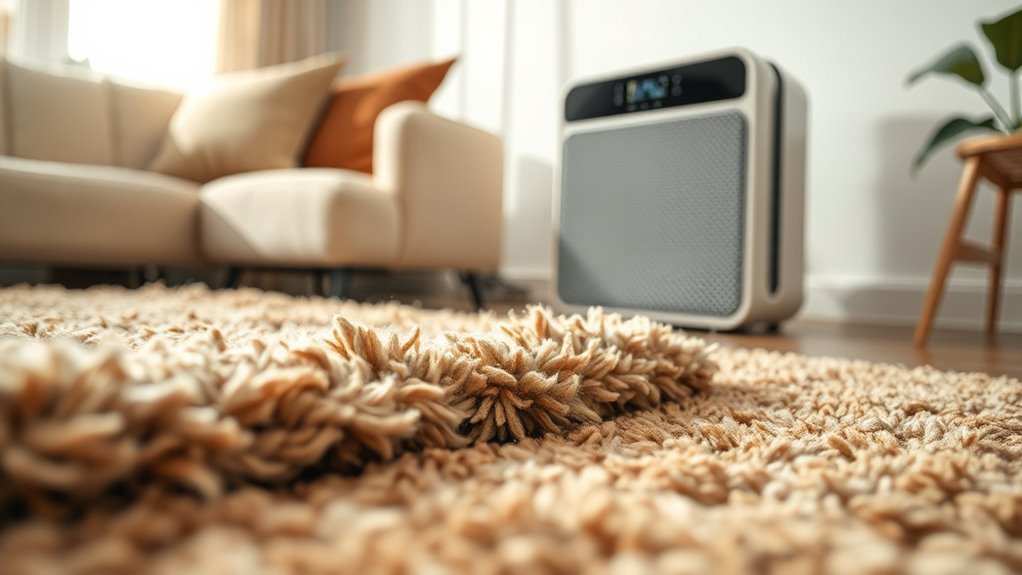
Choosing low-emission rugs starts with paying attention to the materials and manufacturing labels. Look for rugs labeled as low-VOC or formaldehyde-free to reduce indoor air pollution. Opt for natural fiber options like wool rugs, which typically emit fewer chemicals than synthetic alternatives. When selecting area rugs, check for certifications such as Green Label Plus or OEKO-TEX, indicating safer manufacturing processes. Avoid rugs made from synthetic fibers or treated with chemical dyes. Consider purchasing from reputable brands known for eco-friendly practices. Also, inquire about the rug’s production process to guarantee minimal chemical use. By choosing wool rugs and scrutinizing labels, you can considerably lower formaldehyde emissions and improve your indoor air quality.
Methods to Reduce Formaldehyde Levels in Your Home

To lower formaldehyde levels, you should improve your home’s ventilation to help exhaust indoor pollutants. Choosing low-emitting products and regularly cleaning your rugs can also make a big difference. These steps work together to create healthier indoor air quality.
Increase Ventilation Efficiency
Improving ventilation is one of the most effective ways to lower formaldehyde levels in your home. Enhancing air exchange guarantees fresh air replaces indoor pollutants, reducing their concentration. To optimize airflow, consider these strategies:
- Increase the use of exhaust fans in kitchens and bathrooms
- Open windows regularly for cross-ventilation
- Use air purifiers with HEPA filters to assist airflow
- Maintain HVAC systems for proper air exchange and airflow optimization
Choose Low-Emitting Products
Using low-emitting products is one of the most effective ways to reduce formaldehyde levels in your home. When choosing area rugs, opt for those made with natural fibers like wool or cotton, which typically emit fewer chemicals. Be sure to check labels for rugs that are certified low-emitting or formaldehyde-free. Pay attention to rug dyes, as synthetic dyes can sometimes contain formaldehyde-releasing chemicals; choose rugs dyed with natural or low-impact dyes instead. Selecting products specifically labeled as low-emitting helps guarantee fewer volatile organic compounds in your indoor air. By making informed choices about your rugs and their dyes, you considerably decrease your exposure to formaldehyde, creating a safer, healthier environment for you and your family.
Regular Rug Cleaning
Regularly cleaning your rugs can substantially reduce formaldehyde levels indoors. The frequency of cleaning depends on rug materials and household activity. For example, synthetic rugs may trap more pollutants, requiring more frequent cleaning, while natural fiber rugs might need less. To improve air quality, consider these practices:
- Vacuum often using a HEPA filter to remove dust and particles
- Steam clean or deep clean rugs periodically
- Shake out lightweight rugs outside regularly
- Use eco-friendly, low-chemical cleaning solutions
Consistent cleaning helps eliminate trapped formaldehyde and other pollutants, especially in high-traffic areas. Adjust cleaning frequency based on rug materials and household conditions to maintain healthier indoor air and minimize formaldehyde exposure.
The Impact of Rug Maintenance on Indoor Air Quality
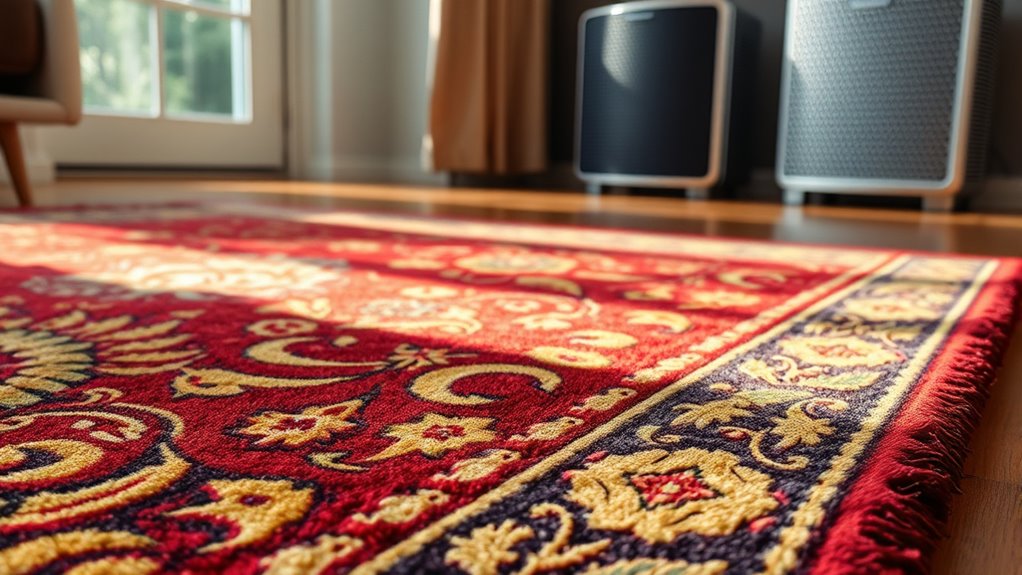
Maintaining your rugs properly is essential because neglecting their care can lead to increased buildup of dust, allergens, and other airborne particles that degrade indoor air quality. Decorative rug styles add aesthetic value but can trap dust if not cleaned regularly. Proper rug placement strategies, like avoiding high-traffic areas or placing rugs on hard surfaces, help reduce dirt accumulation and facilitate easier cleaning. Regular vacuuming and timely professional cleaning remove embedded debris that can release pollutants into the air. Additionally, choosing rugs made from low-emission materials minimizes off-gassing. By staying consistent with maintenance, you prevent the buildup of harmful particles, keeping your indoor air cleaner and healthier for you and your family. Proper care guarantees your rugs contribute positively to your home’s air quality.
Safe Alternatives to Traditional Rugs
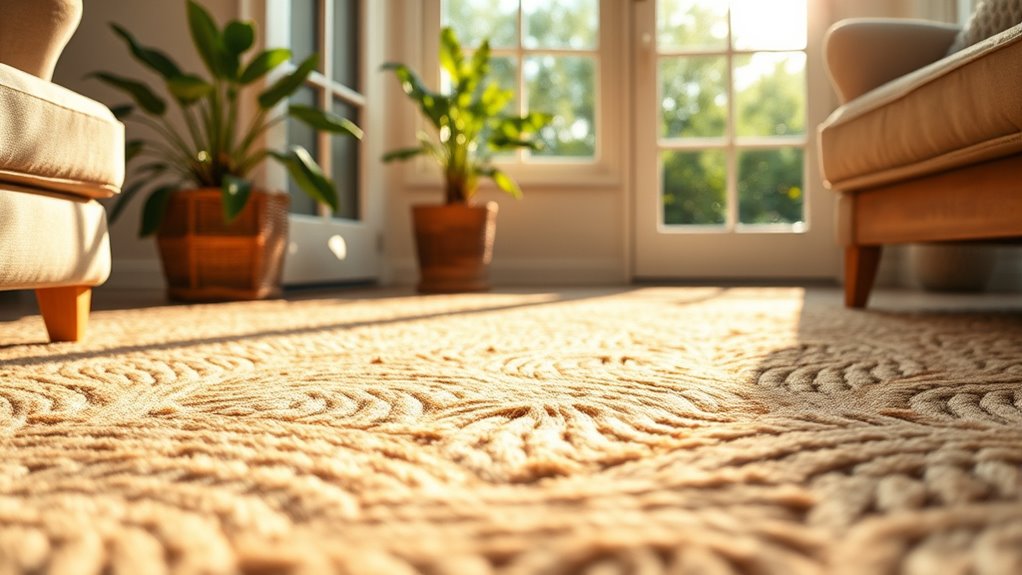
When considering ways to improve indoor air quality, exploring safer alternatives to traditional rugs can make a significant difference. Opt for natural fiber area rugs like wool, jute, or sisal, which usually emit fewer chemicals. Choose rugs made without synthetic backing or dyes to reduce formaldehyde exposure. Use natural, breathable rug padding such as rubber or felt instead of foam, which often contains chemicals. Look for certifications like Green Label Plus or OEKO-TEX to ensure the materials are low in volatile organic compounds. Additionally, consider area rugs that are easy to clean and maintain, as this minimizes dust and allergen buildup. Prioritizing these options helps create a healthier indoor environment and reduces potential chemical emissions from your flooring choices.
Frequently Asked Questions
How Long Does Formaldehyde Off-Gassing Typically Last From Rugs?
You might wonder how long chemical off-gassing lasts from rugs. Typically, formaldehyde emission duration can range from a few days to several months, depending on factors like rug material, ventilation, and temperature. During this period, off-gassing decreases as the formaldehyde gradually dissipates. To reduce exposure, guarantee good air circulation and consider choosing rugs labeled low-emission or formaldehyde-free, which can markedly shorten the emission duration.
Are Natural Fiber Rugs Completely Free of Formaldehyde Emissions?
Imagine a lush, untouched forest—natural fibers seem pure, but they might still carry hidden secrets. While many natural fiber rugs are less likely to emit formaldehyde, some can still be treated with chemicals during manufacturing. So, they’re not always completely free of formaldehyde emissions. Always check labels and opt for rugs labeled as organic or chemical-free to reduce indoor air pollution and breathe easier in your sanctuary.
Can Formaldehyde Exposure From Rugs Cause Long-Term Health Effects?
You might wonder if formaldehyde exposure from rugs could cause long-term health effects. While short-term exposure risks are usually low with natural fiber rugs, prolonged or high-level exposure may contribute to respiratory issues, allergies, or other health concerns over time. To minimize long-term health risks, guarantee good ventilation and choose rugs labeled low in formaldehyde or made from natural, untreated fibers. Staying informed helps protect your indoor air quality.
What Are the Best Ways to Test for Formaldehyde in Home Rugs?
You might wonder if testing your rugs for formaldehyde is necessary. While professional lab tests are most accurate, you can start with DIY methods like air sampling kits designed for home use or using formaldehyde detection strips. Rug cleaning can help reduce emissions, and air purifiers with activated carbon filters can improve indoor air quality. Regular testing makes certain you’re aware of formaldehyde levels and keeps your home safe.
Do Rug Pads Contribute to Formaldehyde Emissions Indoors?
You might wonder if rug pads contribute to indoor pollutant sources like formaldehyde emissions. Rug pad safety varies depending on materials; some may emit volatile organic compounds, including formaldehyde. To minimize exposure, choose pads made from natural, non-toxic materials. You can also guarantee proper ventilation and select pads tested for indoor air quality. Being mindful of rug pad safety helps reduce potential formaldehyde emissions and improves your indoor air environment.
Conclusion
By choosing your rugs wisely and maintaining a vigilant eye on indoor air quality, you hold the power to transform your home into a sanctuary of freshness. Don’t underestimate the threat of formaldehyde lurking beneath your feet—it’s a silent, invisible invader! With mindful decisions and proactive care, you can banish this hidden menace, ensuring every breath you take is pure, safe, and as invigorating as a gust of crisp mountain air.


